Target Information
| Target General Information | Top | |||||
|---|---|---|---|---|---|---|
| Target ID |
T49898
(Former ID: TTDC00166)
|
|||||
| Target Name |
Cyclin-dependent kinase 1 (CDK1)
|
|||||
| Synonyms |
P34CDC2; P34 protein kinase; CDKN1; CDC28A; CDC2
Click to Show/Hide
|
|||||
| Gene Name |
CDK1
|
|||||
| Target Type |
Clinical trial target
|
[1] | ||||
| Disease | [+] 5 Target-related Diseases | + | ||||
| 1 | Breast cancer [ICD-11: 2C60-2C6Y] | |||||
| 2 | Lung cancer [ICD-11: 2C25] | |||||
| 3 | Mature B-cell lymphoma [ICD-11: 2A85] | |||||
| 4 | Solid tumour/cancer [ICD-11: 2A00-2F9Z] | |||||
| 5 | Malignant haematopoietic neoplasm [ICD-11: 2B33] | |||||
| Function |
Required in higher cells for entry into S-phase and mitosis. Phosphorylates PARVA/actopaxin, APC, AMPH, APC, BARD1, Bcl-xL/BCL2L1, BRCA2, CALD1, CASP8, CDC7, CDC20, CDC25A, CDC25C, CC2D1A, CENPA, CSNK2 proteins/CKII, FZR1/CDH1, CDK7, CEBPB, CHAMP1, DMD/dystrophin, EEF1 proteins/EF-1, EZH2, KIF11/EG5, EGFR, FANCG, FOS, GFAP, GOLGA2/GM130, GRASP1, UBE2A/hHR6A, HIST1H1 proteins/histone H1, HMGA1, HIVEP3/KRC, LMNA, LMNB, LMNC, LBR, LATS1, MAP1B, MAP4, MARCKS, MCM2, MCM4, MKLP1, MYB, NEFH, NFIC, NPC/nuclear pore complex, PITPNM1/NIR2, NPM1, NCL, NUCKS1, NPM1/numatrin, ORC1, PRKAR2A, EEF1E1/p18, EIF3F/p47, p53/TP53, NONO/p54NRB, PAPOLA, PLEC/plectin, RB1, UL40/R2, RAB4A, RAP1GAP, RCC1, RPS6KB1/S6K1, KHDRBS1/SAM68, ESPL1, SKI, BIRC5/survivin, STIP1, TEX14, beta-tubulins, MAPT/TAU, NEDD1, VIM/vimentin, TK1, FOXO1, RUNX1/AML1, SAMHD1, SIRT2 and RUNX2. CDK1/CDC2-cyclin-B controls pronuclear union in interphase fertilized eggs. Essential for early stages of embryonic development. During G2 and early mitosis, CDC25A/B/C-mediated dephosphorylation activates CDK1/cyclin complexes which phosphorylate several substrates that trigger at least centrosome separation, Golgi dynamics, nuclear envelope breakdown and chromosome condensation. Once chromosomes are condensed and aligned at the metaphase plate, CDK1 activity is switched off by WEE1- and PKMYT1-mediated phosphorylation to allow sister chromatid separation, chromosome decondensation, reformation of the nuclear envelope and cytokinesis. Inactivated by PKR/EIF2AK2- and WEE1-mediated phosphorylation upon DNA damage to stop cell cycle and genome replication at the G2 checkpoint thus facilitating DNA repair. Reactivated after successful DNA repair through WIP1-dependent signaling leading to CDC25A/B/C-mediated dephosphorylation and restoring cell cycle progression. In proliferating cells, CDK1-mediated FOXO1 phosphorylation at the G2-M phase represses FOXO1 interaction with 14-3-3 proteins and thereby promotes FOXO1 nuclear accumulation and transcription factor activity, leading to cell death of postmitotic neurons. The phosphorylation of beta-tubulins regulates microtubule dynamics during mitosis. NEDD1 phosphorylation promotes PLK1-mediated NEDD1 phosphorylation and subsequent targeting of the gamma-tubulin ring complex (gTuRC) to the centrosome, an important step for spindle formation. In addition, CC2D1A phosphorylation regulates CC2D1A spindle pole localization and association with SCC1/RAD21 and centriole cohesion during mitosis. The phosphorylation of Bcl-xL/BCL2L1 after prolongated G2 arrest upon DNA damage triggers apoptosis. In contrast, CASP8 phosphorylation during mitosis prevents its activation by proteolysis and subsequent apoptosis. This phosphorylation occurs in cancer cell lines, as well as in primary breast tissues and lymphocytes. EZH2 phosphorylation promotes H3K27me3 maintenance and epigenetic gene silencing. CALD1 phosphorylation promotes Schwann cell migration during peripheral nerve regeneration. CDK1-cyclin-B complex phosphorylates NCKAP5L and mediates its dissociation from centrosomes during mitosis. Regulates the amplitude of the cyclic expression of the core clock gene ARNTL/BMAL1 by phosphorylating its transcriptional repressor NR1D1, and this phosphorylation is necessary for SCF(FBXW7)-mediated ubiquitination and proteasomal degradation of NR1D1. Plays a key role in the control of the eukaryotic cell cycle by modulating the centrosome cycle as well as mitotic onset; promotes G2-M transition, and regulates G1 progress and G1-S transition via association with multiple interphase cyclins.
Click to Show/Hide
|
|||||
| BioChemical Class |
Kinase
|
|||||
| UniProt ID | ||||||
| EC Number |
EC 2.7.11.22
|
|||||
| Sequence |
MEDYTKIEKIGEGTYGVVYKGRHKTTGQVVAMKKIRLESEEEGVPSTAIREISLLKELRH
PNIVSLQDVLMQDSRLYLIFEFLSMDLKKYLDSIPPGQYMDSSLVKSYLYQILQGIVFCH SRRVLHRDLKPQNLLIDDKGTIKLADFGLARAFGIPIRVYTHEVVTLWYRSPEVLLGSAR YSTPVDIWSIGTIFAELATKKPLFHGDSEIDQLFRIFRALGTPNNEVWPEVESLQDYKNT FPKWKPGSLASHVKNLDENGLDLLSKMLIYDPAKRISGKMALNHPYFNDLDNQIKKM Click to Show/Hide
|
|||||
| 3D Structure | Click to Show 3D Structure of This Target | PDB | ||||
| HIT2.0 ID | T07TMB | |||||
| Drugs and Modes of Action | Top | |||||
|---|---|---|---|---|---|---|
| Clinical Trial Drug(s) | [+] 6 Clinical Trial Drugs | + | ||||
| 1 | P276-00 | Drug Info | Phase 2 | Mantle cell lymphoma | [4] | |
| 2 | R-roscovitine | Drug Info | Phase 2 | Non-small-cell lung cancer | [5], [6] | |
| 3 | Ro 31-7453 | Drug Info | Phase 2 | Solid tumour/cancer | [7] | |
| 4 | AG-024322 | Drug Info | Phase 1 | Solid tumour/cancer | [1] | |
| 5 | PHA-793887 | Drug Info | Phase 1 | Solid tumour/cancer | [8] | |
| 6 | RGB-286638 | Drug Info | Phase 1 | Haematological malignancy | [9], [10] | |
| Discontinued Drug(s) | [+] 4 Discontinued Drugs | + | ||||
| 1 | SCH 727965 | Drug Info | Discontinued in Phase 3 | Acute lymphoblastic leukaemia | [12], [13], [14] | |
| 2 | BAY 10-00394 | Drug Info | Discontinued in Phase 2 | Small-cell lung cancer | [15], [16] | |
| 3 | R547 | Drug Info | Discontinued in Phase 1 | Advanced solid tumour | [17], [18] | |
| 4 | ZK 304709 | Drug Info | Discontinued in Phase 1 | Advanced solid tumour | [19] | |
| Preclinical Drug(s) | [+] 1 Preclinical Drugs | + | ||||
| 1 | ON-01135 | Drug Info | Preclinical | Solid tumour/cancer | [21] | |
| Mode of Action | [+] 2 Modes of Action | + | ||||
| Inhibitor | [+] 53 Inhibitor drugs | + | ||||
| 1 | P276-00 | Drug Info | [1] | |||
| 2 | R-roscovitine | Drug Info | [1] | |||
| 3 | Ro 31-7453 | Drug Info | [23] | |||
| 4 | AG-024322 | Drug Info | [1] | |||
| 5 | PHA-793887 | Drug Info | [8] | |||
| 6 | RGB-286638 | Drug Info | [24] | |||
| 7 | 4-(thiazol-5-yl)-pyrimidine derivative 2 | Drug Info | [25] | |||
| 8 | Indole-based analog 13 | Drug Info | [25] | |||
| 9 | KENPAULLONE | Drug Info | [26] | |||
| 10 | Naphthyridine and isoquinoline derivative 1 | Drug Info | [25] | |||
| 11 | Oxazolyl methylthiothiazole derivative 1 | Drug Info | [25] | |||
| 12 | PMID25991433-Compound-A1 | Drug Info | [27] | |||
| 13 | Pyrazolo[1,5-a]-1,3,5-triazine derivative 1 | Drug Info | [25] | |||
| 14 | Pyrrolo[2,3-d]pyrimidine derivative 10 | Drug Info | [25] | |||
| 15 | Pyrrolo[2,3-d]pyrimidine derivative 9 | Drug Info | [25] | |||
| 16 | Roscovitine derivative 1 | Drug Info | [25] | |||
| 17 | Tricyclic benzimidazole derivative 1 | Drug Info | [25] | |||
| 18 | SCH 727965 | Drug Info | [1] | |||
| 19 | BAY 10-00394 | Drug Info | [28] | |||
| 20 | R547 | Drug Info | [1] | |||
| 21 | ZK 304709 | Drug Info | [1] | |||
| 22 | ON-01135 | Drug Info | [29] | |||
| 23 | (2,6-Diamino-pyridin-3-yl)-phenyl-methanone | Drug Info | [31] | |||
| 24 | 2-(p-toluidino)-4-phenylpyrimidine-5-carbonitrile | Drug Info | [33] | |||
| 25 | 3,4-bis(indol-3-yl)maleimide derivative | Drug Info | [34] | |||
| 26 | 3,4-di-(4-methoxyphenyl)-1H-pyrrole-2,5-dione | Drug Info | [35] | |||
| 27 | 3,4-diphenyl-1H-pyrrole-2,5-dione | Drug Info | [35] | |||
| 28 | 3-(4-methoxyphenyl)-4-phenyl-1H-pyrrole-2,5-dione | Drug Info | [35] | |||
| 29 | 3-(indole-3-yl)-4-phenyl-1H-pyrrole-2,5-dione | Drug Info | [35] | |||
| 30 | 4-(Quinolin-4-yl)-N-p-tolylpyrimidin-2-amine | Drug Info | [36] | |||
| 31 | 4-phenyl-2-(phenylamino)pyrimidine-5-carbonitrile | Drug Info | [33] | |||
| 32 | 9-Nitropaullone | Drug Info | [37] | |||
| 33 | aloisine A | Drug Info | [38] | |||
| 34 | alsterpaullone 2-cyanoethyl | Drug Info | [39] | |||
| 35 | aminopurvalanol A | Drug Info | [39] | |||
| 36 | AZAKENPAULLONE | Drug Info | [40] | |||
| 37 | Bisindolylmaleimide-I | Drug Info | [34] | |||
| 38 | BMS-265246 | Drug Info | [41] | |||
| 39 | Cdk1 inhibitor | Drug Info | [39] | |||
| 40 | Cdk1/2 inhibitor III | Drug Info | [42] | |||
| 41 | CGP74514A | Drug Info | [43] | |||
| 42 | CVT-313 | Drug Info | [39] | |||
| 43 | JNJ-7706621 | Drug Info | [47] | |||
| 44 | K00024 | Drug Info | [48] | |||
| 45 | Microxine | Drug Info | [49] | |||
| 46 | NU6140 | Drug Info | [50] | |||
| 47 | PF-228 | Drug Info | [51] | |||
| 48 | PMID18986805C9b | Drug Info | [52] | |||
| 49 | PMID19115845C89S | Drug Info | [53] | |||
| 50 | Purvalanol A | Drug Info | [37] | |||
| 51 | Quinoxaline1 | Drug Info | [39] | |||
| 52 | RO-316233 | Drug Info | [34] | |||
| 53 | Thieno analogue of kenpaullone | Drug Info | [40] | |||
| Binder | [+] 5 Binder drugs | + | ||||
| 1 | Olomoucine | Drug Info | [30] | |||
| 2 | 10Z-Hymenialdisine | Drug Info | [32] | |||
| 3 | IN1535 | Drug Info | [44] | |||
| 4 | Indirubin-5-sulfonate | Drug Info | [45], [46] | |||
| 5 | SU9516 | Drug Info | [54] | |||
| Cell-based Target Expression Variations | Top | |||||
|---|---|---|---|---|---|---|
| Cell-based Target Expression Variations | ||||||
| Drug Binding Sites of Target | Top | |||||
|---|---|---|---|---|---|---|
| Ligand Name: AZD-5438 | Ligand Info | |||||
| Structure Description | CDK1/CyclinB/Cks2 in complex with AZD5438 | PDB:6GU3 | ||||
| Method | X-ray diffraction | Resolution | 2.65 Å | Mutation | Yes | [55] |
| PDB Sequence |
LGSMEDYTKI
7 EKIGEGTYGV17 VYKGRHKTTG27 QVVAMKKIRL37 ESEEEGVPST47 AIREISLLKE 57 LRHPNIVSLQ67 DVLMQDSRLY77 LIFEFLSMDL87 KKYLDSIPPG97 QYMDSSLVKS 107 YLYQILQGIV117 FCHSRRVLHR127 DLKPQNLLID137 DKGTIKLADF147 GLARAFGIPI 157 RVYTHEVVTL167 WYRSPEVLLG177 SARYSTPVDI187 WSIGTIFAEL197 ATKKPLFHGD 207 SEIDQLFRIF217 RALGTPNNEV227 WPEVESLQDY237 KNTFPKWKPG247 SLASHVKNLD 257 ENGLDLLSKM267 LIYDPAKRIS277 GKMALNHPYF287 ND
|
|||||
|
|
||||||
| Click to View More Binding Site Information of This Target and Ligand Pair | ||||||
| Ligand Name: NU-6102 | Ligand Info | |||||
| Structure Description | CDK1/CyclinB1/CKS2 in complex with NU6102 | PDB:5LQF | ||||
| Method | X-ray diffraction | Resolution | 2.06 Å | Mutation | No | [56] |
| PDB Sequence |
LGSMEDYTKI
7 EKIGEGTYGV17 VYKGRHKTTG27 QVVAMKKIRL37 ESEEEGVPST47 AIREISLLKE 57 LRHPNIVSLQ67 DVLMQDSRLY77 LIFEFLSMDL87 KKYLDSIPPG97 QYMDSSLVKS 107 YLYQILQGIV117 FCHSRRVLHR127 DLKPQNLLID137 DKGTIKLADF147 GLARAFGIPI 157 RVVTLWYRSP172 EVLLGSARYS182 TPVDIWSIGT192 IFAELATKKP202 LFHGDSEIDQ 212 LFRIFRALGT222 PNNEVWPEVE232 SLQDYKNTFP242 KWKPGSLASH252 VKNLDENGLD 262 LLSKMLIYDP272 AKRISGKMAL282 NHPYFND
|
|||||
|
|
||||||
| Click to View More Binding Site Information of This Target with Different Ligands | ||||||
| Different Human System Profiles of Target | Top |
|---|---|
|
Human Similarity Proteins
of target is determined by comparing the sequence similarity of all human proteins with the target based on BLAST. The similarity proteins for a target are defined as the proteins with E-value < 0.005 and outside the protein families of the target.
A target that has fewer human similarity proteins outside its family is commonly regarded to possess a greater capacity to avoid undesired interactions and thus increase the possibility of finding successful drugs
(Brief Bioinform, 21: 649-662, 2020).
Human Tissue Distribution
of target is determined from a proteomics study that quantified more than 12,000 genes across 32 normal human tissues. Tissue Specificity (TS) score was used to define the enrichment of target across tissues.
The distribution of targets among different tissues or organs need to be taken into consideration when assessing the target druggability, as it is generally accepted that the wider the target distribution, the greater the concern over potential adverse effects
(Nat Rev Drug Discov, 20: 64-81, 2021).
Human Pathway Affiliation
of target is determined by the life-essential pathways provided on KEGG database. The target-affiliated pathways were defined based on the following two criteria (a) the pathways of the studied target should be life-essential for both healthy individuals and patients, and (b) the studied target should occupy an upstream position in the pathways and therefore had the ability to regulate biological function.
Targets involved in a fewer pathways have greater likelihood to be successfully developed, while those associated with more human pathways increase the chance of undesirable interferences with other human processes
(Pharmacol Rev, 58: 259-279, 2006).
Biological Network Descriptors
of target is determined based on a human protein-protein interactions (PPI) network consisting of 9,309 proteins and 52,713 PPIs, which were with a high confidence score of ≥ 0.95 collected from STRING database.
The network properties of targets based on protein-protein interactions (PPIs) have been widely adopted for the assessment of target’s druggability. Proteins with high node degree tend to have a high impact on network function through multiple interactions, while proteins with high betweenness centrality are regarded to be central for communication in interaction networks and regulate the flow of signaling information
(Front Pharmacol, 9, 1245, 2018;
Curr Opin Struct Biol. 44:134-142, 2017).
Human Similarity Proteins
Human Tissue Distribution
Human Pathway Affiliation
Biological Network Descriptors
|
|
|
Note:
If a protein has TS (tissue specficity) scores at least in one tissue >= 2.5, this protein is called tissue-enriched (including tissue-enriched-but-not-specific and tissue-specific). In the plots, the vertical lines are at thresholds 2.5 and 4.
|
| KEGG Pathway | Pathway ID | Affiliated Target | Pathway Map |
|---|---|---|---|
| Cell cycle | hsa04110 | Affiliated Target |
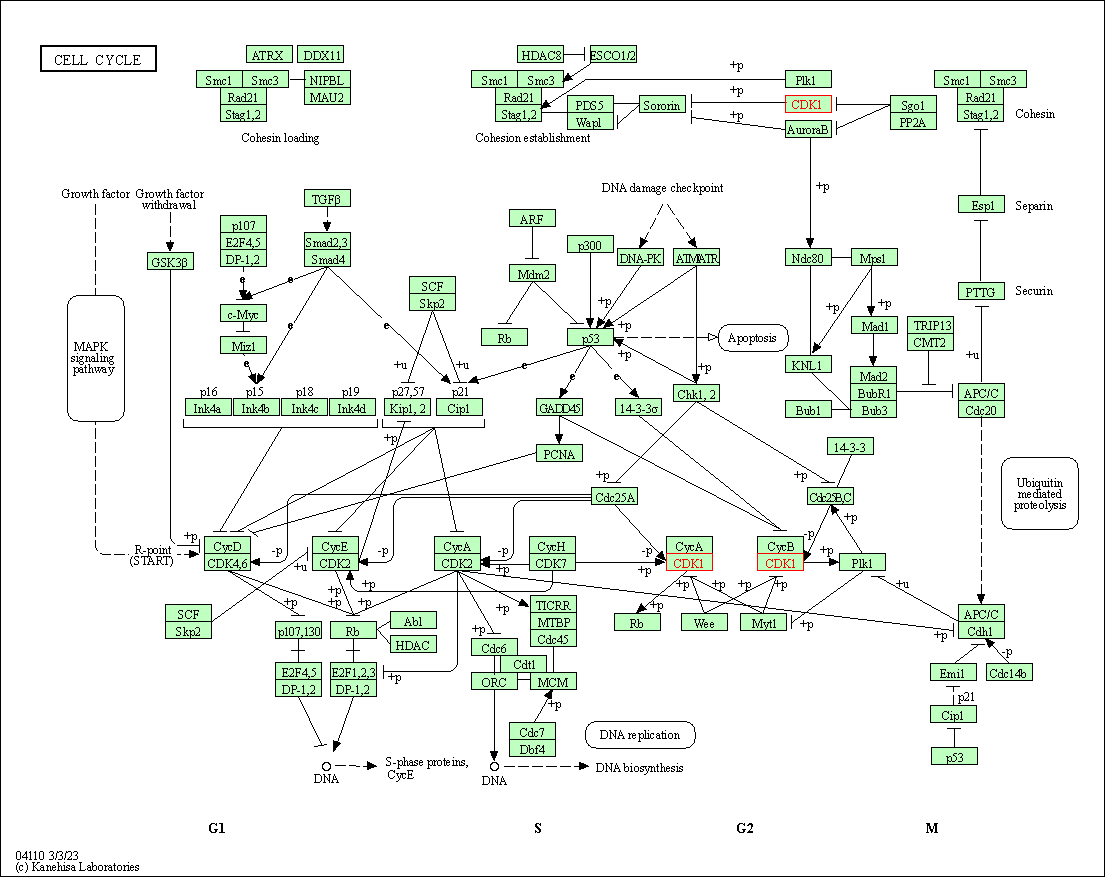
|
| Class: Cellular Processes => Cell growth and death | Pathway Hierarchy | ||
| Oocyte meiosis | hsa04114 | Affiliated Target |
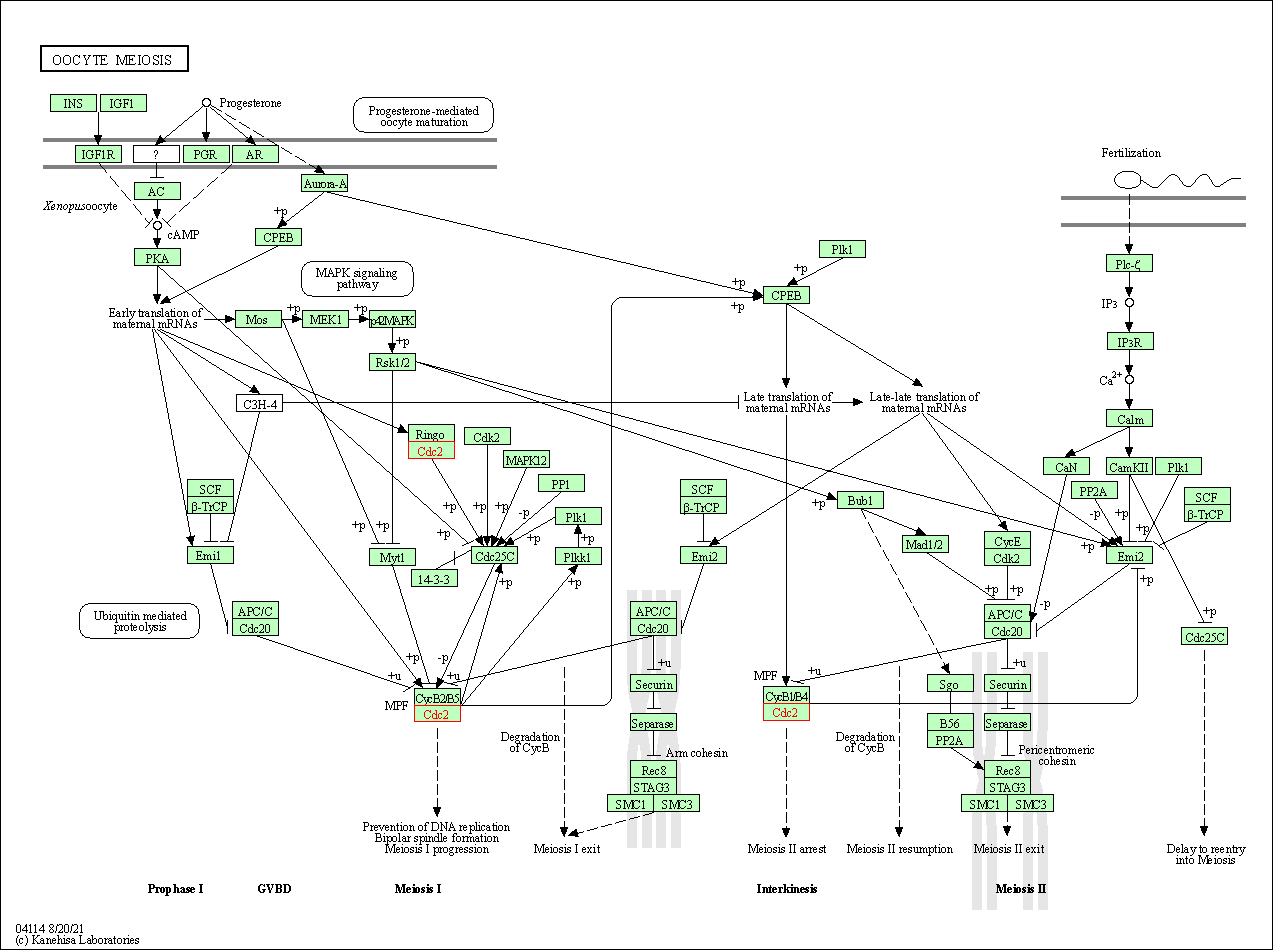
|
| Class: Cellular Processes => Cell growth and death | Pathway Hierarchy | ||
| p53 signaling pathway | hsa04115 | Affiliated Target |
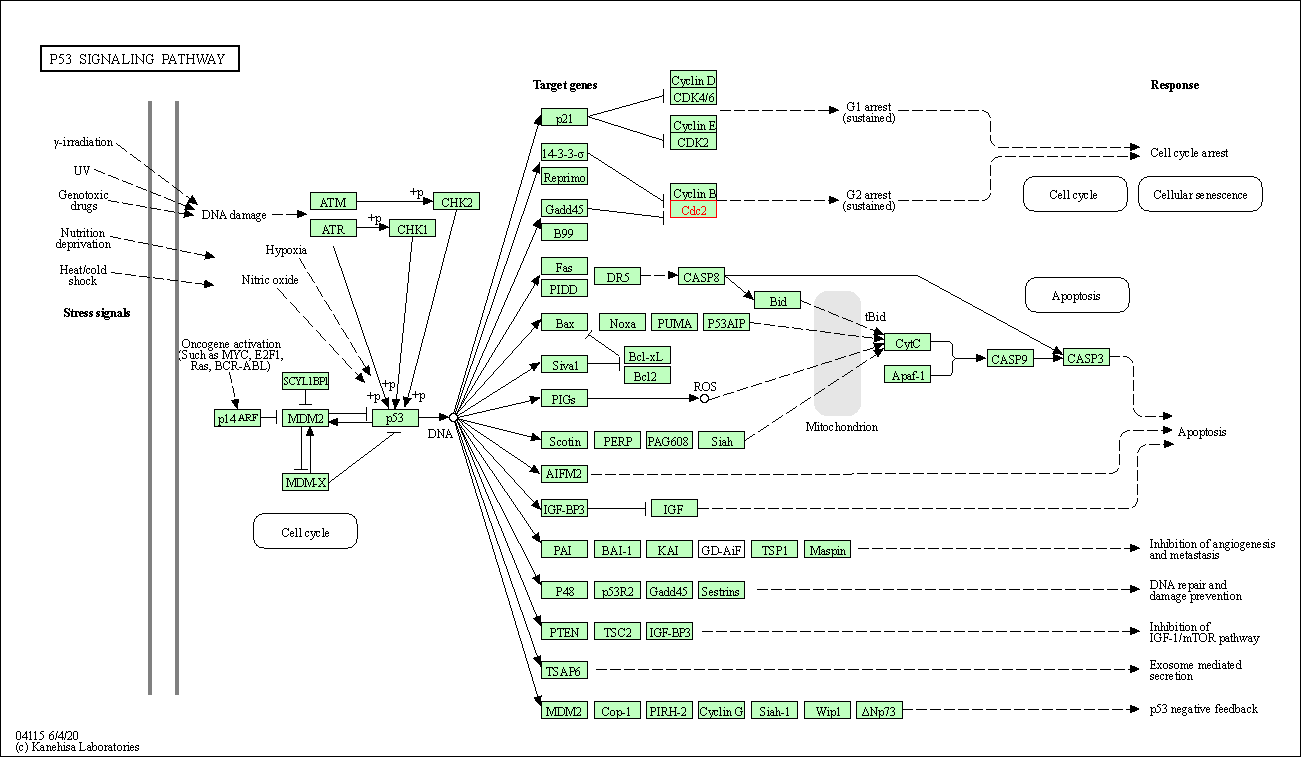
|
| Class: Cellular Processes => Cell growth and death | Pathway Hierarchy | ||
| Cellular senescence | hsa04218 | Affiliated Target |

|
| Class: Cellular Processes => Cell growth and death | Pathway Hierarchy | ||
| Gap junction | hsa04540 | Affiliated Target |
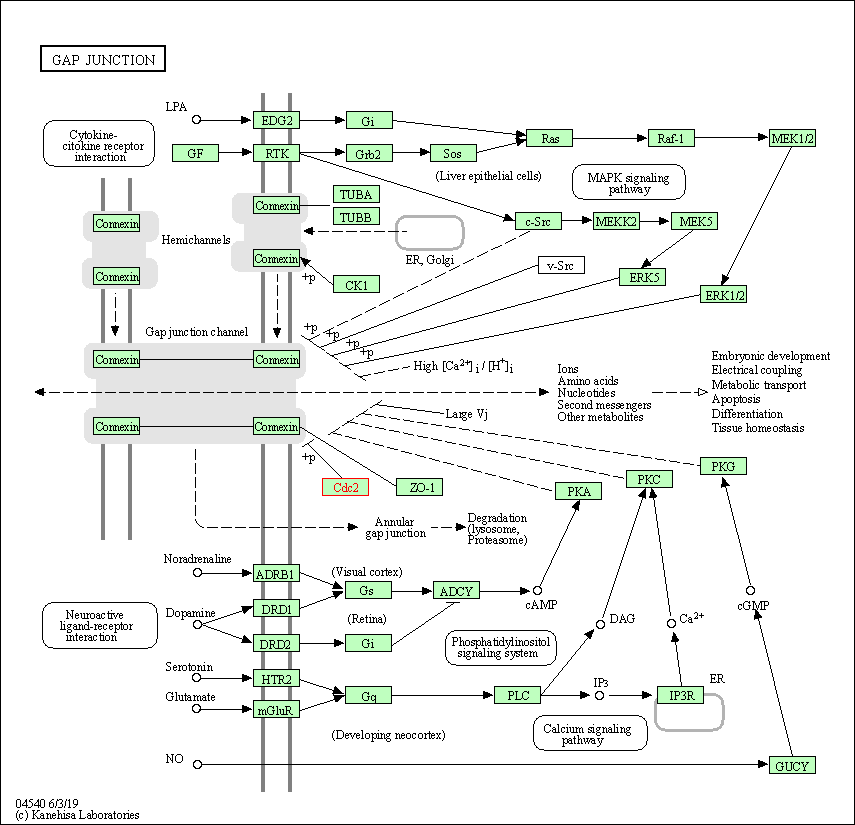
|
| Class: Cellular Processes => Cellular community - eukaryotes | Pathway Hierarchy | ||
| Progesterone-mediated oocyte maturation | hsa04914 | Affiliated Target |
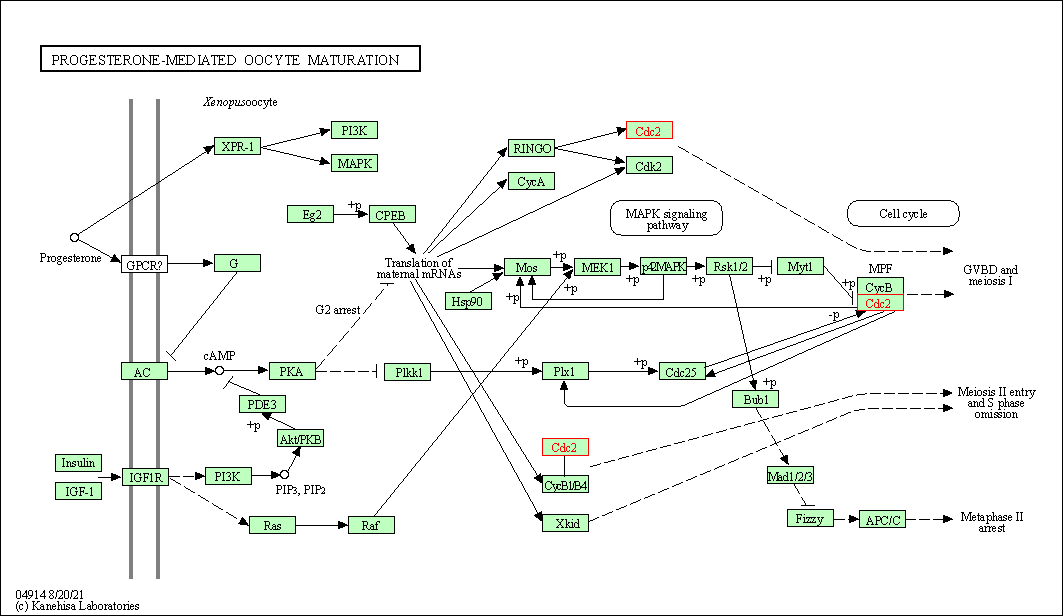
|
| Class: Organismal Systems => Endocrine system | Pathway Hierarchy | ||
| Click to Show/Hide the Information of Affiliated Human Pathways | |||
| Degree | 129 | Degree centrality | 1.39E-02 | Betweenness centrality | 1.12E-02 |
|---|---|---|---|---|---|
| Closeness centrality | 2.56E-01 | Radiality | 1.44E+01 | Clustering coefficient | 1.27E-01 |
| Neighborhood connectivity | 3.34E+01 | Topological coefficient | 3.35E-02 | Eccentricity | 12 |
| Download | Click to Download the Full PPI Network of This Target | ||||
| Chemical Structure based Activity Landscape of Target | Top |
|---|---|
| Drug Property Profile of Target | Top | |
|---|---|---|
| (1) Molecular Weight (mw) based Drug Clustering | (2) Octanol/Water Partition Coefficient (xlogp) based Drug Clustering | |
|
|
||
| (3) Hydrogen Bond Donor Count (hbonddonor) based Drug Clustering | (4) Hydrogen Bond Acceptor Count (hbondacc) based Drug Clustering | |
|
|
||
| (5) Rotatable Bond Count (rotbonds) based Drug Clustering | (6) Topological Polar Surface Area (polararea) based Drug Clustering | |
|
|
||
| "RO5" indicates the cutoff set by lipinski's rule of five; "D123AB" colored in GREEN denotes the no violation of any cutoff in lipinski's rule of five; "D123AB" colored in PURPLE refers to the violation of only one cutoff in lipinski's rule of five; "D123AB" colored in BLACK represents the violation of more than one cutoffs in lipinski's rule of five | ||
| Co-Targets | Top | |||||
|---|---|---|---|---|---|---|
| Co-Targets | ||||||
| Target Poor or Non Binders | Top | |||||
|---|---|---|---|---|---|---|
| Target Poor or Non Binders | ||||||
| Target Regulators | Top | |||||
|---|---|---|---|---|---|---|
| Target-regulating microRNAs | ||||||
| Target-interacting Proteins | ||||||
| Target Profiles in Patients | Top | |||||
|---|---|---|---|---|---|---|
| Target Expression Profile (TEP) | ||||||
| Target-Related Models and Studies | Top | |||||
|---|---|---|---|---|---|---|
| Target Validation | ||||||
| References | Top | |||||
|---|---|---|---|---|---|---|
| REF 1 | Cell cycle kinases as therapeutic targets for cancer. Nat Rev Drug Discov. 2009 Jul;8(7):547-66. | |||||
| REF 2 | URL: http://www.guidetopharmacology.org Nucleic Acids Res. 2015 Oct 12. pii: gkv1037. The IUPHAR/BPS Guide to PHARMACOLOGY in 2016: towards curated quantitative interactions between 1300 protein targets and 6000 ligands. (Ligand id: 7934). | |||||
| REF 3 | P276-00, a novel cyclin-dependent inhibitor induces G1-G2 arrest, shows antitumor activity on cisplatin-resistant cells and significant in vivo efficacy in tumor models. Mol Cancer Ther. 2007 Mar;6(3):926-34. | |||||
| REF 4 | A phase II, single-arm, open-label, multicenter study to evaluate the efficacy and safety of P276-00, a cyclin-dependent kinase inhibitor, in patients with relapsed or refractory mantle cell lymphoma. Clin Lymphoma Myeloma Leuk. 2015 Jul;15(7):392-7. | |||||
| REF 5 | URL: http://www.guidetopharmacology.org Nucleic Acids Res. 2015 Oct 12. pii: gkv1037. The IUPHAR/BPS Guide to PHARMACOLOGY in 2016: towards curated quantitative interactions between 1300 protein targets and 6000 ligands. (Ligand id: 6035). | |||||
| REF 6 | Trusted, scientifically sound profiles of drug programs, clinical trials, safety reports, and company deals, written by scientists. Springer. 2015. Adis Insight (drug id 800010117) | |||||
| REF 7 | A phase 2 study of oral MKC-1, an inhibitor of importin-beta, tubulin, and the mTOR pathway in patients with unresectable or metastatic pancreatic cancer. Invest New Drugs. 2012 Aug;30(4):1614-20. | |||||
| REF 8 | A first in man, phase I dose-escalation study of PHA-793887, an inhibitor of multiple cyclin-dependent kinases (CDK2, 1 and 4) reveals unexpected h... Cell Cycle. 2011 Mar 15;10(6):963-70. | |||||
| REF 9 | URL: http://www.guidetopharmacology.org Nucleic Acids Res. 2015 Oct 12. pii: gkv1037. The IUPHAR/BPS Guide to PHARMACOLOGY in 2016: towards curated quantitative interactions between 1300 protein targets and 6000 ligands. (Ligand id: 7744). | |||||
| REF 10 | ClinicalTrials.gov (NCT01168882) Safety and Tolerability of RGB-286638 in Patients With Selected, Relapsed or Refractory Hematological Malignancies. U.S. National Institutes of Health. | |||||
| REF 11 | Glycogen synthase kinase 3 (GSK-3) inhibitors: a patent update (2014-2015).Expert Opin Ther Pat. 2017 Jun;27(6):657-666. | |||||
| REF 12 | URL: http://www.guidetopharmacology.org Nucleic Acids Res. 2015 Oct 12. pii: gkv1037. The IUPHAR/BPS Guide to PHARMACOLOGY in 2016: towards curated quantitative interactions between 1300 protein targets and 6000 ligands. (Ligand id: 7379). | |||||
| REF 13 | Dinaciclib, a novel CDK inhibitor, demonstrates encouraging single-agent activity in patients with relapsed multiple myeloma. Blood. 2015 Jan 15;125(3):443-8. | |||||
| REF 14 | Cyclin-dependent kinase inhibitor Dinaciclib (SCH727965) inhibits pancreatic cancer growth and progression in murine xenograft models. Cancer Biol Ther. 2011 Oct 1;12(7):598-609. | |||||
| REF 15 | URL: http://www.guidetopharmacology.org Nucleic Acids Res. 2015 Oct 12. pii: gkv1037. The IUPHAR/BPS Guide to PHARMACOLOGY in 2016: towards curated quantitative interactions between 1300 protein targets and 6000 ligands. (Ligand id: 7874). | |||||
| REF 16 | BAY 1000394, a novel cyclin-dependent kinase inhibitor, with potent antitumor activity in mono- and in combination treatment upon oral application. Mol Cancer Ther. 2012 Oct;11(10):2265-73. | |||||
| REF 17 | URL: http://www.guidetopharmacology.org Nucleic Acids Res. 2015 Oct 12. pii: gkv1037. The IUPHAR/BPS Guide to PHARMACOLOGY in 2016: towards curated quantitative interactions between 1300 protein targets and 6000 ligands. (Ligand id: 5707). | |||||
| REF 18 | Trusted, scientifically sound profiles of drug programs, clinical trials, safety reports, and company deals, written by scientists. Springer. 2015. Adis Insight (drug id 800018924) | |||||
| REF 19 | Trusted, scientifically sound profiles of drug programs, clinical trials, safety reports, and company deals, written by scientists. Springer. 2015. Adis Insight (drug id 800022386) | |||||
| REF 20 | Emerging drugs for obesity: linking novel biological mechanisms to pharmaceutical pipelines. Expert Opin Emerg Drugs. 2005 Aug;10(3):643-60. | |||||
| REF 21 | Trusted, scientifically sound profiles of drug programs, clinical trials, safety reports, and company deals, written by scientists. Springer. 2015. Adis Insight (drug id 800020976) | |||||
| REF 22 | Trusted, scientifically sound profiles of drug programs, clinical trials, safety reports, and company deals, written by scientists. Springer. 2015. Adis Insight (drug id 800010054) | |||||
| REF 23 | A comparison of physicochemical property profiles of marketed oral drugs and orally bioavailable anti-cancer protein kinase inhibitors in clinical development. Curr Top Med Chem. 2007;7(14):1408-22. | |||||
| REF 24 | Small-molecule multi-targeted kinase inhibitor RGB-286638 triggers P53-dependent and -independent anti-multiple myeloma activity through inhibition of transcriptional CDKs. Leukemia. 2013 Dec;27(12):2366-75. | |||||
| REF 25 | Cyclin-dependent kinase inhibitors for cancer therapy: a patent review (2009 - 2014).Expert Opin Ther Pat. 2015;25(9):953-70. | |||||
| REF 26 | Discovery of novel CDK1 inhibitors by combining pharmacophore modeling, QSAR analysis and in silico screening followed by in vitro bioassay. Eur J Med Chem. 2010 Sep;45(9):4316-30. | |||||
| REF 27 | c-Jun N-terminal kinase inhibitors: a patent review (2010 - 2014).Expert Opin Ther Pat. 2015;25(8):849-72. | |||||
| REF 28 | National Cancer Institute Drug Dictionary (drug id 770319). | |||||
| REF 29 | Phase 1 study of intravenous rigosertib (ON 01910.Na), a novel benzyl styryl sulfone structure producing G2/M arrest and apoptosis, in adult patients with advanced cancer. Am J Cancer Res. 2013; 3(3): 323-338. | |||||
| REF 30 | Antiproliferative activity of olomoucine II, a novel 2,6,9-trisubstituted purine cyclin-dependent kinase inhibitor. Cell Mol Life Sci. 2005 Aug;62(15):1763-71. | |||||
| REF 31 | 3-Acyl-2,6-diaminopyridines as cyclin-dependent kinase inhibitors: synthesis and biological evaluation. Bioorg Med Chem Lett. 2005 May 2;15(9):2221-4. | |||||
| REF 32 | DrugBank: a knowledgebase for drugs, drug actions and drug targets. Nucleic Acids Res. 2008 Jan;36(Database issue):D901-6. | |||||
| REF 33 | 4-Aryl-5-cyano-2-aminopyrimidines as VEGF-R2 inhibitors: synthesis and biological evaluation. Bioorg Med Chem Lett. 2007 Jun 15;17(12):3266-70. | |||||
| REF 34 | Design of new inhibitors for cdc2 kinase based on a multiple pseudosubstrate structure. Bioorg Med Chem Lett. 1998 May 5;8(9):1019-22. | |||||
| REF 35 | Design, synthesis, and biological evaluation of 3,4-diarylmaleimides as angiogenesis inhibitors. J Med Chem. 2006 Feb 23;49(4):1271-81. | |||||
| REF 36 | Synthesis and cytotoxic activity of 2-methylimidazo[1,2-a]pyridine- and quinoline-substituted 2-aminopyrimidine derivatives. Eur J Med Chem. 2010 Jan;45(1):379-86. | |||||
| REF 37 | Down-regulation of survivin in nitric oxide-induced cell growth inhibition and apoptosis of the human lung carcinoma cells. J Biol Chem. 2004 May 7;279(19):20267-76. | |||||
| REF 38 | Aloisines, a new family of CDK/GSK-3 inhibitors. SAR study, crystal structure in complex with CDK2, enzyme selectivity, and cellular effects. J Med Chem. 2003 Jan 16;46(2):222-36. | |||||
| REF 39 | A systematic interaction map of validated kinase inhibitors with Ser/Thr kinases. Proc Natl Acad Sci U S A. 2007 Dec 18;104(51):20523-8. | |||||
| REF 40 | 1-Azakenpaullone is a selective inhibitor of glycogen synthase kinase-3 beta. Bioorg Med Chem Lett. 2004 Jan 19;14(2):413-6. | |||||
| REF 41 | A robust high-content imaging approach for probing the mechanism of action and phenotypic outcomes of cell-cycle modulators. Mol Cancer Ther. 2011 Feb;10(2):242-54. | |||||
| REF 42 | 1-Acyl-1H-[1,2,4]triazole-3,5-diamine analogues as novel and potent anticancer cyclin-dependent kinase inhibitors: synthesis and evaluation of biological activities. J Med Chem. 2005 Jun 30;48(13):4208-11. | |||||
| REF 43 | 2,6,9-trisubstituted purines: optimization towards highly potent and selective CDK1 inhibitors. Bioorg Med Chem Lett. 1999 Jan 4;9(1):91-6. | |||||
| REF 44 | M-phase regulation of the recruitment of mRNAs onto polysomes using the CDK1/cyclin B inhibitor aminopurvalanol. Biochem Biophys Res Commun. 2003 Jul 11;306(4):880-6. | |||||
| REF 45 | How many drug targets are there Nat Rev Drug Discov. 2006 Dec;5(12):993-6. | |||||
| REF 46 | Binding of the potential antitumour agent indirubin-5-sulphonate at the inhibitor site of rabbit muscle glycogen phosphorylase b. Comparison with ligand binding to pCDK2-cyclin A complex. Eur J Biochem. 2004 Jun;271(11):2280-90. | |||||
| REF 47 | Synthesis and evaluation of N-acyl sulfonamides as potential prodrugs of cyclin-dependent kinase inhibitor JNJ-7706621. Bioorg Med Chem Lett. 2006 Jul 15;16(14):3639-41. | |||||
| REF 48 | Synthesis, structure-activity relationship, and biological studies of indolocarbazoles as potent cyclin D1-CDK4 inhibitors. J Med Chem. 2003 May 22;46(11):2027-30. | |||||
| REF 49 | Microxine, a new cdc2 kinase inhibitor from the Australian marine sponge Microxina species. J Nat Prod. 2001 Apr;64(4):525-6. | |||||
| REF 50 | Potentiation of paclitaxel-induced apoptosis by the novel cyclin-dependent kinase inhibitor NU6140: a possible role for survivin down-regulation. Mol Cancer Ther. 2005 Sep;4(9):1328-37. | |||||
| REF 51 | Cellular characterization of a novel focal adhesion kinase inhibitor. J Biol Chem. 2007 May 18;282(20):14845-52. | |||||
| REF 52 | Imidazole pyrimidine amides as potent, orally bioavailable cyclin-dependent kinase inhibitors. Bioorg Med Chem Lett. 2008 Dec 15;18(24):6486-9. | |||||
| REF 53 | First Cdc7 kinase inhibitors: pyrrolopyridinones as potent and orally active antitumor agents. 2. Lead discovery. J Med Chem. 2009 Jan 22;52(2):293-307. | |||||
| REF 54 | SU9516: biochemical analysis of cdk inhibition and crystal structure in complex with cdk2. Biochem Biophys Res Commun. 2003 Oct 24;310(3):1026-31. | |||||
| REF 55 | Differences in the Conformational Energy Landscape of CDK1 and CDK2 Suggest a Mechanism for Achieving Selective CDK Inhibition. Cell Chem Biol. 2019 Jan 17;26(1):121-130.e5. | |||||
| REF 56 | Cyclin-Dependent Kinase (CDK) Inhibitors: Structure-Activity Relationships and Insights into the CDK-2 Selectivity of 6-Substituted 2-Arylaminopurines. J Med Chem. 2017 Mar 9;60(5):1746-1767. | |||||
If You Find Any Error in Data or Bug in Web Service, Please Kindly Report It to Dr. Zhou and Dr. Zhang.

